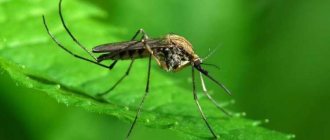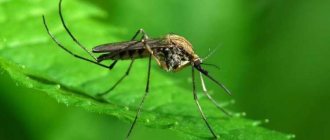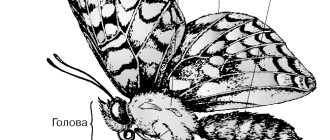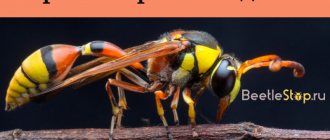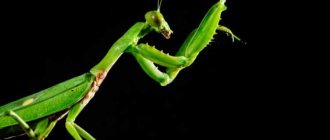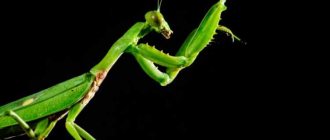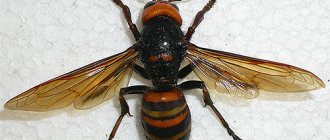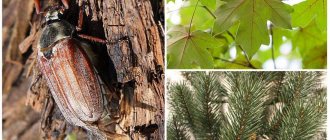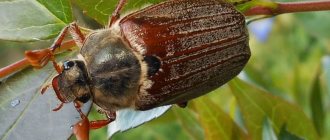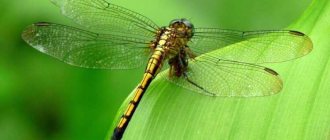- Wild animals
- >>
- Insects
If you observe, at the end of April and beginning of May you will notice that medium-sized beetles gradually crawl out of the ground and quickly fly into the air. This insect is called the cockchafer . This is the most famous pest that causes great losses in the agricultural sphere of human life. Despite this, the cockchafer is a rather interesting animal with its own habits and way of life.
Body structure of the cockchafer
Adults have an oval-shaped body, divided into the front part - the chest and the back part - the abdomen. The head is round in shape, partially retracted into the front of the back. Large eyes are located on the upper side of the head. They consist of many simple eyes, expanding the range of visibility.
In the photo of the cockchafer, antennae with brushes at the ends are clearly visible. They perform the functions of the olfactory organs and search for food. The front pair of legs originate from the chest and are extended forward in the direction of movement. The second and third pairs of legs lie along the body. The elytra with strong ribs have a protective function. The wings unfold over the body.
Individuals grow up to 3 cm, males are smaller than females. The elytra are dull red or yellow. The body of the beetle is black or brown in color, covered with small hairs or scales with a high coating density. The palps on the jaw are organs of touch. Beetles have a well-developed sensory system.
Internal structure
Respiratory system
It is made up of many tubes with branches (tracheas). They deliver air entering the body through the spiracles to other systems.
Digestive system
The upper jaws bite off parts of the leaves, and the lower jaws grind them. The food then passes into the esophagus and from there into the stomach . It is equipped with teeth made of chitin to grind food. The remainder of the digestion process occurs in the intestines , and processed food is excreted through the anus.
Excretory system
A bunch of tubes closed at the top, the bases extend into the intestines. Their task is to filter metabolic products and convert them into crystalline substances.
Circulatory system
Blood does not take part in respiration; it only carries nutrients to the organs, carrying excretory products away from them. Moves due to the functioning of the heart.
Nervous system
Primitive, contains a peripharyngeal ring and an abdominal chain. The brain is a collection of nerve cells fused together.
Reproductive system
How does the cockchafer reproduce? The female has a pair of ovaries , which connect to form an oviduct. It brings the eggs formed in the ovaries out after maturation. To receive the seed there is a special reservoir - seminal receptacle .
The male has testes , they pass into the vas deferens and connect into a single canal for ejaculation.
insect eggs
What do cockchafer eggs look like? May beetle egg - photo:
Compared to the eggs of other insects, they are quite large - their length is 3 mm, width 2 mm. The color is dirty white, the shape is oval, widened on the sides.
The egg goes through a development cycle of about 30 days . The presence of unfavorable conditions extends it to 45-50 days. Eggs tend to gradually harden , beginning development under soft covers.
Life cycle of the cockchafer
The lifespan of an insect is affected by environmental factors: climate, abundance of food. Under favorable conditions they live up to 5 years.
The development of the cockchafer consists of 4 forms of existence:
- Egg
- Larva
- Doll
- Adult
Insects lay eggs. The larvae are released from the clutches. Insects spend 3 years in this form. The habitat chosen is soil in which they can easily move, taking advantage of their body features. They grow up to 6 cm. They eat plant roots.
After multiple molts, the cockchafer larvae, ready to move to a new stage, pupate. Within one month, the organs necessary for the existence of an adult develop and wings grow.
At the end of the summer months, a full-fledged cockchafer emerges from the protective covers of the pupa. In anticipation of a drop in temperature, the insect hides in the ground, where it will spend time until spring.
Distribution and habitats
May beetles are widespread throughout Europe and Asia. It is found in the northern part of the European steppe region, in Siberia - in the taiga and forest-steppe zone. Prevails in northern and central Europe in clearings on sandy soils.
The northern border of the habitat passes through Arkhangelsk, in the east it follows from Yakutia along the Pacific coast to Beijing. The southern border in Europe is the Danube River, then it follows the line - Odessa, Zaporozhye, Altai, Shanghai.
How to get rid of cockchafers be found in a separate article on the website. Some practical recommendations are proposed, as well as chemical and biological preparations that are used to control soil pests.
May beetle nutrition
Adults prefer to eat young leaves of trees. The diet that cockchafers eat includes herbal flowers and leaves of cultivated plants. The leaves of berry bushes are not ignored.
Pupae and eggs do not feed on plant matter. The larvae gnaw on the rhizomes of plants and trees.
Risk factors and benefits
The May beetle (Khrushchev) is one of the main pests of gardens and forests. Adult insects cause harm by eating leaves on trees. Beetles love to feast on young leaves of berry bushes and fruit trees. In addition to garden plantings, beetles eat birch, willow, maple, aspen, hazel and many others. other deciduous, as well as coniferous plants. Among fruit trees they like plums and walnuts, and among forest trees they like oak.
They rarely feed on grass leaves and flowers, but among cultivated plants they prefer flowers of roses, rose hips, apple trees, pears, carrots, cabbage, beets, poppies, irises, mustard, rye and corn.
As a result, young plants die completely, and adult fruit and berry plants are stunted in growth and do not produce a full harvest.
The larvae eat the roots of young plantings. The main damage to the roots is caused by 2-3 year old larvae, eating the roots during the entire vegetative period of plant development - from May to September. Their diet includes roots of various herbaceous and woody plants. They have no special dietary preferences.
Despite the harm, the cockchafer is beneficial because... they are food for birds and amphibians (hedgehogs, snakes, lizards). They are great for fishing.
Types of cockchafer
Comparing what chafers of different subspecies look like, common features for all are obvious. The lamellar insect family includes the genus of May beetles and the genus of bronze beetles.
The types include:
- Khrushchev May Transcaucasian
- Eastern May Khrushchev
- Western May Khrushchev
Transcaucasian species of cockchafer
It has a wide body and a glossy surface. The color is dark brown, with a black head and the beginning of the back. The elytra, antennae, and paws are painted in shades of brown.
They prefer to have woody vegetation of the Caucasian region in their diet. Summer in a moderately humid warm climate begins at the end of April. The larvae avoid dry soil and move deeper into the soil.
Eastern Khrushchev
Has changing color. The jaw bears curved palps. The head is covered with dark specks and pale yellow hairs. The paws are small in thickness.
Individuals living in the Siberian taiga feed on young oak leaves and other forest plantings. Pine trees are especially affected. Summer begins in mid-May. In the warm conditions of the southern steppe and forest-steppe in mid-April.
Western Khrushchev
Capable of growing over 3 cm in length. The back is convex. The color of the head and the beginning of the back is dark. The tarsi, antennae, and palps can range from light brown to black. The elytra are sandy and brown in color. There are white triangular spots on the sides. The elytra are covered with noticeable white hairs; on the body they are gray. There are sparse light hairs on the sides. The chest is covered with densely growing light gray hairs.
Years depend entirely on air temperature. The warm season begins at the end of April. They feed on deciduous plants, leaves of trees and shrubs. They react to light. Beetles are active in dim light, in the evening and in the morning.
Bronzovka
The green May beetle is part of the same family as the May beetle. The green bronzeback is nicknamed the Maybug, which it is not, although it is closely related.
The insect has an oval body with a small head. The front pair of legs are extended forward. The second pair starts from the chest. The third pair is the largest, stretched along the body. The wings are straightened for flight through slits in the elytra.
The bronze body surface has a characteristic tint. All types of insects have brilliant colors. The structure of the wing elytra of bronzes and May beetles differs, as does the length of the legs and the shape of the antennae.
The color performs a protective function; most of the bronzes chose lands with a tropical climate and bright vegetation as their habitat. Common colors are green, red, purple, blue, yellow, and white.
Plant flowers, tree sap, and overripe fruits are used as food.
The larvae that emerge from the eggs live in rotting, decayed anthills, forest litter, and wood.
Features of development and behavior
The flight of beetles occurs from the 2nd half of May to the end of June, isolated flights are observed until the beginning of August. But in the southern regions, the flight of beetles already begins in the 3rd decade of April.
The flight of the cockchafer is a mystery of nature. According to the laws of aerodynamics, such an insect cannot fly!!!
Usually, single males appear first, and after a week the females begin flying. Beetles begin to fly at dusk, after sunset. By midnight the flight stops. During flight, beetles sit on trees and feed. Beetles can fly out in the morning as well as at night, reacting to artificial lighting.
Different types of beetles are active at different times of the day. Both males and females fly equally well. But in some species, females fly little or not at all.
May beetle (Khrushchev) in flight
By the way, the flight of the cockchafer is a mystery of nature. According to the laws of aerodynamics known to mankind, a beetle with such a body should not fly. Its wings are not developed enough to lift such a body into the air. But the cockchafer does not know about this, and flies at speeds of up to 3 m/sec. In a day it can fly up to 20 km, rising to a height of up to 100 m.
The cockchafer lives 5-7 weeks.
And the larvae live in the soil for 2-3 years, and
Life cycle of the cockchafer
The beetles are common in European and Asian territories. Adults are able to fly for several days, only a month and a half. They prefer the dark to search for food.
Prevalence
As already mentioned, the geography of habitat of cockchafers is very extensive - they are found in European regions, in the CIS countries, and Central Asia, the Caucasus, and North America are no exception. Even the northern Palearctic was not left without these pests. At the moment, nine species of insects are typical for Russian regions.
Their favorite habitats are rivers and forests. They love loose sandy or sandy loam soil. The exception is clay soils, which are not suitable for beetle breeding.
Reproduction of the cockchafer
After the pupa transforms into a female beetle, 2 or 3 weeks pass and the female is fertilized by the males. The masonry is buried in the soil at a shallow depth.
The female regains her strength by feeding abundantly and repeats all reproductive cycles up to 4 times, dying on the last one. After this, up to 70 larvae will hatch in a month.
Preventive measures
It is impossible to completely prevent the beetle from moving around the area. Also, sometimes prevention does not bring the desired benefit, because the larvae remain in the soil for a long time. To try to reduce or prevent the appearance of pests you need to:
- dig up the soil in the fall, adding bleach or bleach;
- in the spring, water the beds with water and ammonia;
- plant white creeping clover near fruit crops to accumulate nitrogen;
- In spring, add chicken shells to the soil;
- in the spring, place birdhouses to attract birds;
- plant elderberries, cabbage, turnips - they repel parasites with the smell.
Methods of combating the cockchafer
Harm is caused by adults and larvae. They spoil the roots and stems and leaves of plants.
They dig up the ground, destroying the larvae and eggs. Beetles are collected from plants and then destroyed.
Plants are treated with chemicals to destroy the larvae.
Spraying biological pesticides attracts birds that feed on beetles.
Interesting facts about May Khrushchev
Hairy cockchafer.
A few facts about the cockchafer:
- the insect is capable of flying, although it does not have enough lift coefficient - scientists believe that flight is impossible with such indicators;
- the beetle is distinguished by its determination - it moves towards its goal, not paying attention to obstacles;
- Thanks to their extraordinary appetite, the larvae can eat pine roots within 24 hours.
Photos of all types of cockchafer
Species of the genus Polyphylla
Of the representatives of this genus, 3 species live on the territory of Russia:
- white;
- marble;
- Caucasian marble;
In this genus of May beetles, the main color is often hidden by scales that cover the body of the beetle.
White Khrushchev
Size 2.5-3.5 cm. It would be very similar to the western cockchafer, if not for the white scales densely covering the body. The male's main brown background is completely hidden.
The species is Central Asian, actively penetrating the European part of Russia. Already widespread in Crimea in the Evpatoria region. Lives in sandy soil.
Marble Khrushchev
Other names: motley Khrushchev or July Khrushchev. Adults emerge in July, hence the second name. The size of the cockchafer is 2.5-4 cm. The color is dark brown. On the elytra there are light spots formed by bristles. This characteristic pattern gave the insect its name. For life it chooses sandy soils.
Range: almost all of Europe. In Russia, the northern border runs through the Kursk, Voronezh, and Penza regions. Southern - along the coast of the Black and Azov Seas up to Anapa.
Caucasian marble
A large beetle 3-3.8 cm long and 14-19 mm wide. Color black/brownish-black. The dorsal part has a white pattern of scales. They live in dense soil. During the day they hide in the ground, at night they lead an active lifestyle.
Distributed in Central and Asia Minor, Greece and Transcaucasia.
Species of the genus Polyphylla
Habitat
The cockchafer lives almost everywhere, except in places where there is permafrost. In Russia it is distributed everywhere, including Yakutia.
The eastern species likes to settle in high treetops, while the western species prefers hills and hills to live.
The larva remains underground until the adult hatches: in the spring it moves closer to the roots, and in the winter it goes to a depth of 1 m.
Planting lupine for preventive purposes
Lupine is an excellent green manure that improves the quality characteristics of the soil, promotes its aeration, saturates it with nitrogen and prevents the growth of weeds. And since there will be no weeds in the plot where it is planted, the larvae will not get anything for “lunch” except the roots of the lupine itself, which for them is pure poison!
People's advice often mentions bleach, which actually works against the beetle, but the priority should always be the feasibility of one method or another, and in the case of chlorine it is questionable. Many gardening crops do not tolerate such “feeding” well, which is why in agricultural technology there are restrictions on the addition of even beneficial potassium chloride. But mulching the soil during crop growth and sowing green manure after harvesting will benefit fruiting, make the farmer’s work easier, and an excellent preventive measure against pest beetles.

